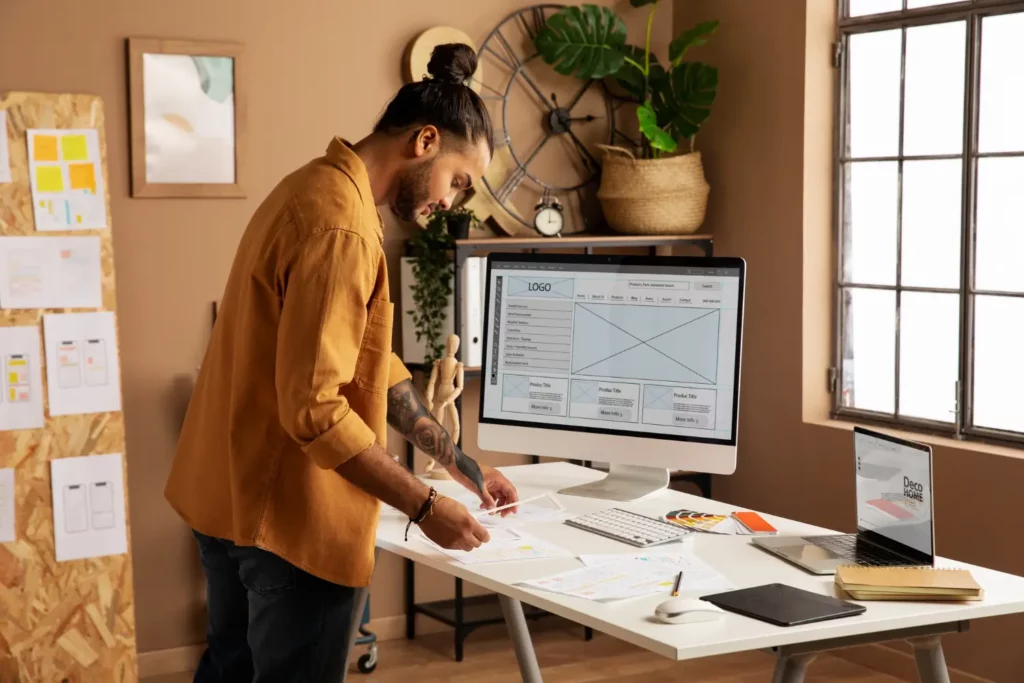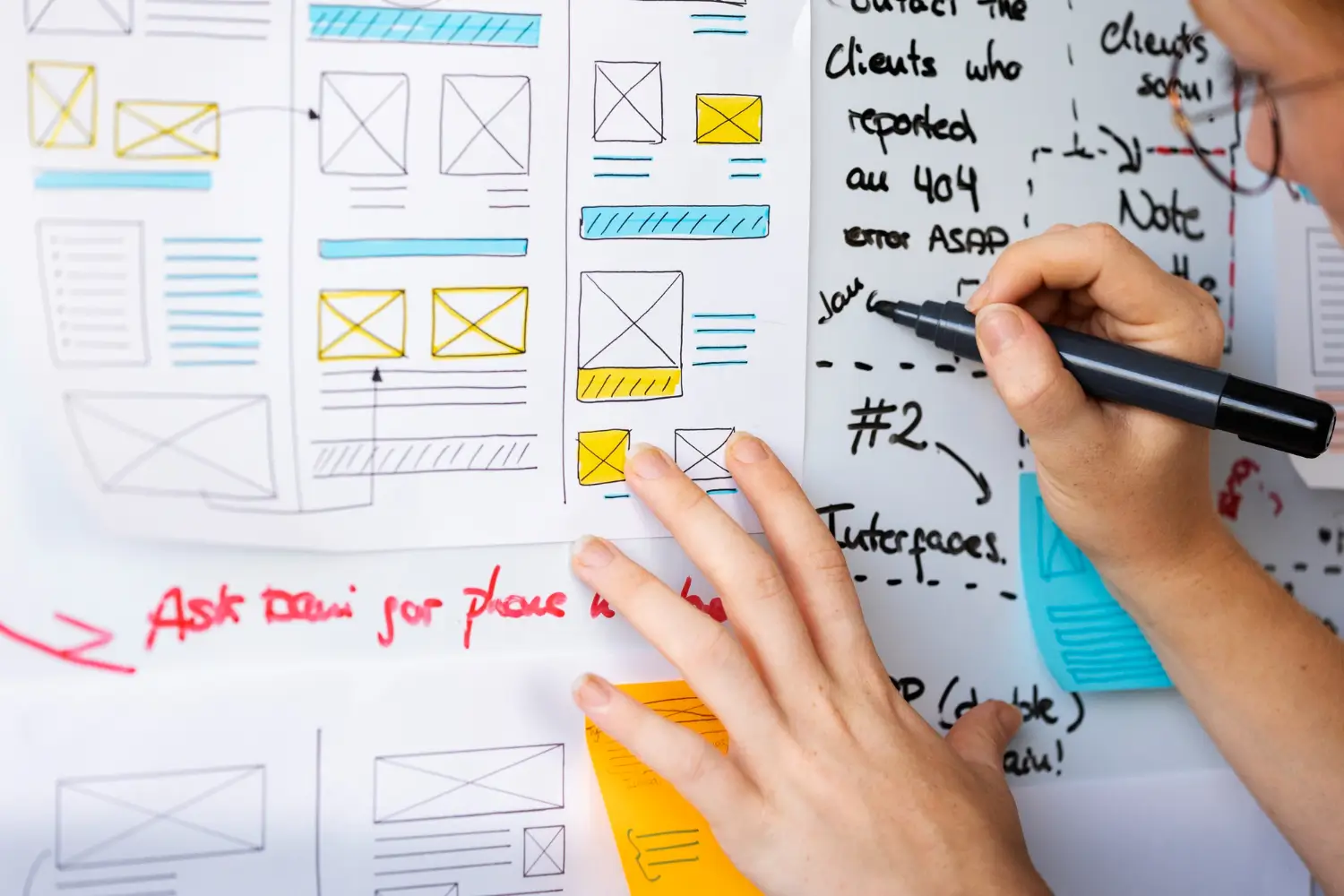Parallax scrolling is a captivating and immersive web design technique that has gained widespread popularity in recent years.
This article will provide you with a fundamental understanding of parallax scrolling and its significance in modern web design.
What is Parallax Scrolling?
Parallax scrolling is a design technique that involves the foreground and background elements of a web page moving at different speeds as the user scrolls down or across the page. This creates a dynamic and visually engaging experience, giving the illusion of depth and dimension to the content. In simpler terms, it’s like looking out of a moving car window, where objects closer to you appear to move faster than those in the distance.
Parallax scrolling allows web designers to craft visually stunning websites that tell a story, showcase products, or convey information in a more engaging manner. It adds an element of interactivity and immersion, making it an essential tool in the modern web designer’s toolkit.
Here is an example of the parallax effect in action from one of our recent projects:
History and Evolution
The roots of parallax scrolling can be traced back to early video games and animation. It was initially popularized in 2D side-scrolling video games, where different layers of graphics moved independently to create a sense of depth and motion. This technique was later adapted for web design, with early examples emerging in the early 2010s.
As technology advanced and web development tools improved, parallax scrolling became more accessible to designers. It evolved from simple effects to complex, multi-layered designs, allowing for a wide range of creative possibilities.
Importance in Modern Web Design
In modern web design, parallax scrolling is more than just a trendy visual effect—it serves various essential purposes:
- Enhanced User Engagement: Parallax scrolling captures users’ attention and encourages them to explore the website further. It keeps visitors engaged and reduces bounce rates.
- Storytelling and Narrative: It’s an excellent tool for conveying a narrative or guiding users through a story, making it particularly popular for portfolios, product launches, and brand storytelling.
- Visual Appeal and Creativity: Parallax scrolling allows designers to showcase their creativity and produce visually stunning websites that stand out in a crowded online landscape.
- Differentiation: It helps businesses and brands distinguish themselves from competitors by offering a unique and memorable online experience.
Parallax scrolling has evolved from its humble beginnings in video games to become a powerful design technique used to engage users, tell stories, and create visually appealing websites. Its importance in modern web design cannot be overstated, as it continues to shape the way we interact with and experience websites.
How Parallax Scrolling Works
Understanding the mechanics behind parallax scrolling is crucial for harnessing its creative potential.
Layers and Depth Perception
At the heart of parallax scrolling is the concept of layers and depth perception. Imagine a web page as a stack of transparent sheets, each containing different elements such as text, images, or graphics. As users scroll down or across the page, these layers move independently at varying speeds, creating an illusion of depth and dimension.
Depth perception is achieved by manipulating the speed and direction of movement for each layer. Elements in the foreground move faster than those in the background, simulating the way objects appear to shift relative to one another as we move through space. This dynamic interplay between layers captivates users and gives the website a three-dimensional quality, making it visually engaging and memorable.
Vertical vs. Horizontal Parallax
Parallax scrolling can be applied both vertically and horizontally, depending on the design goals and the content’s layout.
Vertical parallax is the most common form of parallax scrolling, where elements move at different speeds vertically as users scroll down the page. It’s ideal for storytelling, product showcases, and creating a sense of depth in a one-page website.
In horizontal parallax, elements move horizontally as users scroll from left to right or vice versa. This variation is less common but can be used effectively for unique navigation experiences or to simulate a side-scrolling video game feel.
Implementing Parallax with HTML/CSS/JavaScript
To bring parallax scrolling to life on a website requires a combination of HTML, CSS, and JavaScript. Here’s a simplified overview of the implementation process:
- HTML: Structuring the content with HTML, creating the necessary sections and elements that will be animated.
- CSS: Styling the elements, including defining their positions, sizes, and initial appearances. CSS also plays a role in setting up the layers and creating the parallax effect by adjusting properties like background positions.
- JavaScript: Adding interactivity and animation through JavaScript. This scripting language enables you to control the speed and direction of movement for each layer based on the user’s scroll position. There are also libraries and frameworks, such as ScrollMagic or AOS, that simplify the implementation of parallax effects.
In the upcoming sections, we will explore these technical aspects in more detail, providing you with practical guidance on how to implement parallax scrolling in your web projects. Understanding these technicalities will empower you to create captivating and seamless parallax experiences for your users.

Benefits of Using Parallax Scrolling
Parallax scrolling isn’t just a trendy design choice; it offers a range of tangible benefits for web designers and website visitors alike.
Enhanced User Engagement
One of the primary benefits of parallax scrolling is its ability to captivate and engage users. By introducing dynamic motion and depth to your website, you can create an interactive and immersive browsing experience. Here’s how it enhances user engagement:
- Attention-Grabbing: Parallax scrolling immediately draws the user’s attention as they encounter the dynamic movement of elements. This can help reduce bounce rates and encourage visitors to explore your site further.
- Smoother Navigation: Parallax websites often have a single-page layout, which means users can seamlessly scroll to access all the content. This reduces the need for clicking through multiple pages, resulting in a more fluid and user-friendly experience.
- Increased Time on Page: Users tend to spend more time on parallax-scrolling websites because the engaging visuals and storytelling elements encourage them to delve deeper into the content.
Storytelling and Narrative
Parallax scrolling is a powerful storytelling tool. It allows you to guide users through a narrative or convey a message in a compelling and sequential manner. Here’s how it supports storytelling:
- Visual Storytelling: Through the coordinated movement of elements, you can craft a visual narrative that unfolds as users scroll. This is particularly effective for showcasing products, telling brand stories, or presenting case studies.
- Emotional Impact: By combining visuals, text, and animations, you can evoke emotions and create a memorable experience. Whether you’re sharing a cause, promoting a product, or narrating a brand’s journey, parallax scrolling enhances the emotional resonance of your content.
- Sequential Information: Parallax scrolling can break down complex information into easily digestible sections, guiding users step by step through your content. This is especially valuable for tutorials, guides, or educational websites.

Visual Appeal and Creativity
Parallax scrolling empowers designers to push the boundaries of creativity and aesthetics. It allows for the creation of visually stunning websites that leave a lasting impression. Here’s why it’s a boon for visual appeal:
- Unique Design: Parallax websites stand out from the crowd, offering a fresh and memorable visual experience. This uniqueness can help differentiate your brand or project in a competitive online landscape.
- Immersive Graphics: The illusion of depth and motion in parallax scrolling makes graphics and images come alive. This can be particularly advantageous for industries like fashion, art, and entertainment, where visuals play a significant role.
- Endless Possibilities: Designers have the freedom to experiment with various parallax effects, layering techniques, and creative animations. This versatility allows for endless possibilities in design and user interaction.
Parallax scrolling offers a trifecta of benefits: increased user engagement, a powerful tool for storytelling, and the ability to create visually stunning and creative websites. When used thoughtfully, it can elevate your web design projects to new heights, leaving a lasting impact on your audience.
Considerations and Best Practices
While parallax scrolling can be a fantastic addition to your web design toolbox, it’s essential to navigate this creative technique with care.
Performance Optimization
Loading Speed
Parallax scrolling can introduce complex animations and graphics, potentially slowing down your website’s loading time. To optimize performance, compress images, minimize code, and use lazy loading techniques to load content as users scroll.
Mobile Optimization
Ensure that your parallax effects are well-optimized for mobile devices. Mobile users may have limited bandwidth, so it’s crucial to balance visual effects with performance on smaller screens.
Browser Compatibility
Test your parallax website on various browsers to ensure compatibility. Some older browsers may not fully support modern parallax techniques, so you may need to provide fallback options or graceful degradation.
Accessibility and SEO
Keyboard Navigation
Make sure your parallax scrolling website is navigable using a keyboard. Some users rely on keyboard navigation due to disabilities, and it’s essential to provide a seamless experience for them.
Screen Readers
Ensure that screen readers can interpret and convey the content effectively. Provide alt text for images, use semantic HTML, and structure your content logically.
Search Engine Optimization
Parallax websites can present SEO challenges because all content is on a single page. To improve SEO, use descriptive headings, meaningful URLs, and meta tags. Also, consider creating a sitemap and using schema markup.
Responsive Design
Mobile-First Approach
Start your design process with a mobile-first mindset. Design for smaller screens and gradually enhance the experience for larger devices. This approach ensures that your parallax effects work seamlessly on all screen sizes.
Media Queries
Implement responsive design techniques using media queries in CSS. These queries enable you to adjust the layout and styling based on screen size, ensuring a consistent and user-friendly experience.
Testing Across Devices
Test your parallax scrolling website on a variety of devices, including smartphones, tablets, and desktop computers. This helps identify and address any responsiveness issues.
Performance on Touchscreens
Consider how your parallax effects work on touchscreen devices. Ensure that gestures like swiping and pinching are compatible with your design and don’t interfere with the user experience.
By paying careful attention to these considerations and best practices, you can create a parallax scrolling website that not only dazzles users with its visual appeal but also ensures a smooth and accessible experience for all visitors, while maintaining optimal performance and SEO visibility.
How to Add Parallax Scrolling to Your Website
Now that we’ve explored the concept and benefits of parallax scrolling, let’s dive into the practical aspects of implementing this dynamic technique in your web design projects.
Step-by-Step Implementation Guide
- Planning
Start by outlining your website’s content and identifying areas where parallax scrolling would enhance the user experience. Consider the story you want to tell or the message you want to convey through the parallax effects.
- HTML Structure
Structure your web page with HTML, breaking it into sections or divs. Assign classes or IDs to the elements you intend to animate.
- CSS Styling
Use CSS to style your elements and set their initial positions. You can use properties like background image and background-position to create the parallax effect.
- JavaScript Integration
Incorporate JavaScript to add interactivity and animation. You can use libraries like ScrollMagic, GreenSock Animation Platform (GSAP), or simple vanilla JavaScript to control the speed and direction of element movement as users scroll.
- Testing and Debugging
Regularly test your parallax scrolling website on different devices and browsers to ensure a consistent experience. Debug any issues that may arise, such as misaligned elements or performance bottlenecks.
- Performance Optimization
Optimize your website’s performance by compressing images, using lazy loading, and minimizing unnecessary animations or large files.
- Accessibility and SEO
Ensure that your website remains accessible to all users and maintains good SEO practices. Provide alternative content for non-visual users and optimize your site’s metadata.
Recommended Tools and Libraries
ScrollMagic
ScrollMagic is a popular JavaScript library for creating scroll-based animations, making it easier to implement parallax scrolling effects.
GreenSock Animation Platform (GSAP)
GSAP is a powerful animation library that works seamlessly with JavaScript, allowing you to create complex animations and transitions for your parallax design.
AOS (Animate On Scroll)
AOS is a lightweight JavaScript library that simplifies the process of animating elements as they come into view during scrolling.
Parallax.js
Parallax.js is a straightforward library for adding parallax effects to your website. It’s user-friendly and suitable for beginners.

Tips for Effective Parallax Design
Keep it Subtle
While parallax scrolling can be visually stunning, avoid overloading your website with excessive animations. Subtle parallax effects often work best.
Storytelling
Use parallax scrolling to tell a compelling story or guide users through a narrative. Ensure that your parallax elements contribute to the overall message.
Optimize for Mobile
Prioritize mobile optimization to cater to users on smaller screens. Test thoroughly to ensure a smooth experience on various devices.
Content First
Always prioritize content over flashy effects. Parallax should enhance the content’s presentation, not distract from it.
Testing and User Feedback
Gather feedback from users to gauge their experience with the parallax scrolling effects. Adjust your design based on their feedback to improve usability.
By following these steps, utilizing recommended tools and libraries, and adhering to best practices, you can successfully implement parallax scrolling on your website, creating an engaging and memorable user experience.
Common Mistakes to Avoid
While parallax scrolling can breathe life into your web design, it’s essential to tread carefully and avoid some common pitfalls that can detract from the user experience.
Overdoing Parallax Effects
Overwhelming Animation
One of the most significant mistakes is overloading your website with too many parallax animations. Excessive movement and complexity can distract users and make your site feel chaotic rather than engaging.
Tip: Prioritize quality over quantity
Focus on a few key animations that enhance your content or storytelling rather than bombarding users with numerous effects.
Inconsistent Direction
Inconsistency in the direction and speed of parallax animations can disorient users. It’s essential to maintain a cohesive and logical flow in your design.
Tip: Establish a clear narrative or visual hierarchy in your design. Ensure that all animations contribute to this narrative and follow a consistent pattern.
Ignoring Mobile Users
Non-Responsive Design
Neglecting mobile users by not optimizing your parallax effects for smaller screens is a significant oversight. Mobile users constitute a significant portion of web traffic.
Tip: Prioritize mobile-first design. Test your parallax scrolling website extensively on various mobile devices to ensure a seamless experience.
Performance on Touchscreens
Some parallax effects that work well with mouse scrolling may not translate effectively to touchscreen interactions. Failing to consider touchscreen users can lead to usability issues.
Tip: Test your parallax effects on touchscreen devices and ensure that gestures like swiping and pinching do not interfere with the user experience.
Neglecting Loading Speed
Heavy Graphics and Assets
Using large, unoptimized images or multimedia assets can slow down your website’s loading speed, frustrating users and causing them to bounce.
Tip: Compress and optimize images and videos to reduce their file size. Implement lazy loading to load content as users scroll, reducing the initial load time.
Lack of Performance Monitoring
Failing to monitor and analyze your website’s performance can lead to slow-loading pages over time. Users expect speedy interactions.
Tip: Use performance monitoring tools to regularly assess your website’s speed and identify bottlenecks. Address issues promptly to maintain optimal performance.
Avoiding these common mistakes when implementing parallax scrolling is essential for creating a seamless and engaging user experience. By striking a balance between animation, responsiveness, and performance, you can maximize the benefits of parallax scrolling while delivering a user-friendly website.
Future Trends in Parallax Scrolling
As web design continues to evolve, so does the potential of parallax scrolling.
Emerging Technologies and Innovations
Advanced Animation Techniques
Expect to see more sophisticated animation techniques and tools that push the boundaries of parallax scrolling. These innovations will allow for even more immersive and visually stunning effects.
3D Parallax Scrolling
The integration of three-dimensional elements into parallax scrolling is on the horizon. This will enable designers to create websites that offer an even greater sense of depth and realism.
Interactive Storytelling
Future parallax websites may incorporate interactive storytelling elements, allowing users to make choices that influence the narrative as they scroll.
Integrating VR and AR
Virtual Reality (VR)
The convergence of parallax scrolling with VR technology could result in entirely immersive web experiences. Users equipped with VR headsets might navigate parallax websites as if they were exploring a virtual world.
Augmented Reality (AR)
AR can enhance the interactivity of parallax scrolling. For instance, users could point their smartphones at specific objects on a parallax website to trigger additional information or animations.
WebXR
The adoption of WebXR, a standard for building VR and AR experiences on the web, could pave the way for seamless integration of parallax scrolling with immersive technologies.
User Experience Enhancements
Personalization
Future parallax websites might leverage user data and AI-driven algorithms to personalize the scrolling experience. Content, animations, and narratives could adapt to individual preferences.
Haptic Feedback
As haptic technology advances, it may find its way into parallax websites. Users could feel subtle vibrations or feedback as they interact with elements during scrolling.
Multi-Sensory Experiences
The incorporation of sound, scent, or other sensory elements into parallax scrolling could provide a multisensory experience that engages users on a whole new level.
The future of parallax scrolling in web design holds exciting possibilities. With emerging technologies, VR and AR integration, and enhanced user experiences, parallax scrolling is set to continue evolving, offering designers innovative ways to create captivating and immersive websites.
Staying up-to-date with these trends will be key for web designers looking to push the boundaries of what’s possible with parallax scrolling.
Conclusion and Final Thoughts
In our exploration of parallax scrolling in web design, we’ve covered a wide array of topics, from its fundamentals to best practices, and even glimpsed into its future possibilities.
As we conclude, let’s recap the key takeaways, emphasize the importance of striking a balance between functionality and aesthetics, and consider the evolving role of parallax scrolling in the world of web design.
Recap of Key Takeaways
Parallax Scrolling Defined
Parallax scrolling is a design technique that creates depth and motion on a web page by moving foreground and background elements at different speeds as users scroll.
Benefits of Parallax Scrolling
Parallax scrolling enhances user engagement, supports storytelling, and boosts visual appeal and creativity in web design.
Considerations and Best Practices
To succeed with parallax scrolling, focus on performance optimization, accessibility, SEO, and responsive design.
Implementation Guide
Adding parallax scrolling to your website involves planning, structuring HTML, styling with CSS, integrating JavaScript, testing, and optimizing for various devices.
Common Mistakes to Avoid
Be cautious of overdoing parallax effects, neglecting mobile users, and ignoring loading speed, as these can negatively impact user experience.
Future Trends
Parallax scrolling is evolving with advanced animations, 3D integration, VR and AR, and enhanced user experiences.
Importance of Balancing Functionality and Aesthetics
While parallax scrolling can elevate the aesthetics of a website, it’s vital not to lose sight of its functional aspects. A beautifully designed website should also serve its primary purpose effectively.
Striking the right balance between functionality and aesthetics ensures that your parallax website not only looks appealing but also delivers a seamless user experience, maintains optimal performance, and achieves its intended goals.
The Future Role of the Parallax Scrolling Effect in Web Design
The future of parallax scrolling in web design is promising. As technology advances, we can expect more sophisticated animations, 3D elements, and integrations with VR and AR. Parallax scrolling will continue to be a tool for immersive storytelling and engagement, providing web designers with creative avenues to explore.
As it evolves, parallax scrolling will play an integral role in shaping the future of web design, creating captivating and memorable online experiences for users.
In conclusion, parallax scrolling is a dynamic and evolving technique that, when used thoughtfully and strategically, can transform websites into engaging and immersive digital spaces.
As web designers, staying informed about the latest trends and best practices will be key to harnessing the full potential of parallax scrolling in your projects.
Why Clio Websites
We hope that we helped to understand how to implement parallax scrolling effect in web design. Our recommendations and techniques are based on years of experience helping businesses like yours.
At Clio, we have helped many clients grow their businesses with websites tuned for engagement and conversions.
Contact us if you would like us to help you create a unique website that your visitor will love.



